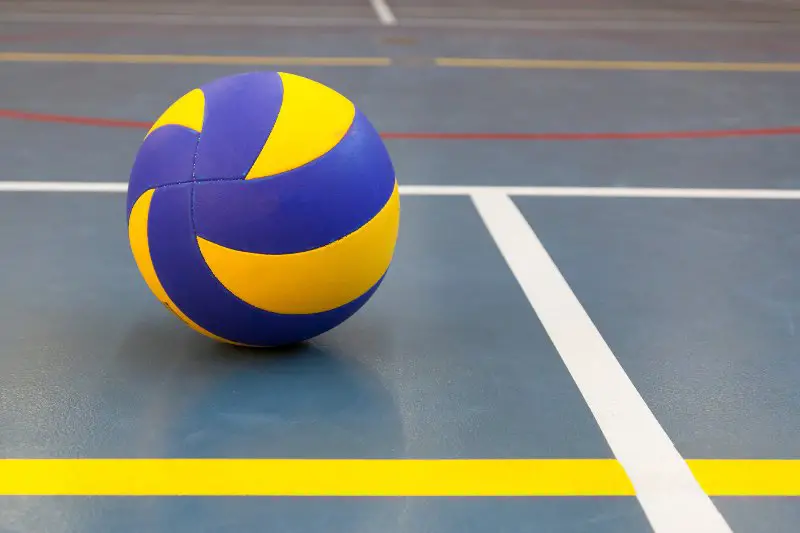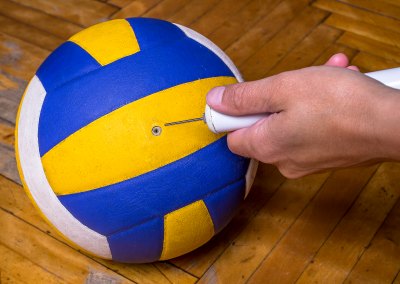
A Volleyball surface could represent an issue for some practitioners especially if they are new to the sport. That’s why, it is definitely not a bad idea to try softening the ball quite a bit to minimize the risks of getting your hands sore after games and practice sessions …
In this article, I give you some interesting insight about that as well as some helpful tips to make volleyball surface softer and more pleasant to touch without really damaging it.
Should a volleyball be hard or soft?
In general, a volleyball should be hard because it is pressurised so it can go through the air and off the hands at a good speed.
If the ball were too soft then many of the basic moves and positions involved in the sport would be much more difficult to execute …
Serves would struggle to clear the net, passes would not reach team mates, and the set and the dig would not reach high enough for the spiker to hit.
At the same time, the ball should not be so hard that it makes it difficult to control or painful to play with.
Many people, when they are starting out, find that the constant impact can hurt the hands and sprain wrists and fingers.
Quick Recommendation: If you are new to the sport and looking for a softer surface ball to start with, then you can check this soft quality ball. Most beginners start with this ball until they get used to the sport and it works out usually very well for them.
While in many cases, these problems disappear and players get more familiar with the techniques involved, not only can this cause injury, but it can also be detrimental to the enjoyment of the sport.
That is one reason why there are softer balls manufactured and sold for training purposes, and also for juniors.
At the same time, it should be recognised that there are now different types of volleyball – not just indoor and beach, but variations played on snow, grass, using the feet or the fists, and that each has their own preference when it comes to relative hardness of the ball.
By the way, I’ve written an helpful article on how to choose a volleyball ball. I highly recommend checking it!
How to soften your volleyball?

The best and safest way to soften a volleyball is to remove some of the air from it. This can be done by using the needle from an air pump.
Unscrew the needle from the pump, and insert it in to the inflation hole on the volleyball, taking the time not to force it. Air should start to come out slowly. Check the hardness of the ball constantly, and, once it has reached the desired level of softness, remove the needle.
It is important when removing the needle not to pull the valve out as well.
The process can be speeded-up by gently pressing on the ball as the air seeps out, but again care should be taken not to exert too much pressure.
If somebody does not have an air pump, then a safety pin can be used instead, but extreme care must be taken to ensure that the ball is not punctured in the process.
It should also be noted that balls tend to soften naturally over time anyway. All balls consist of bladders which have a rubber membrane, filled with air, which is permeable.
Over time, because of the size of the oxygen molecules, they are small enough to pass through the membrane; irrespective of how effective may be the seal around the bladder.
That means that, because of this natural process, it can be possible to give it a helping hand by gently squeezing the ball with the hands placed around the valve.
Naturally only mild pressure should be used because there is a risk that the ball could lose it shape, or even, in extreme circumstances, burst.
What is the softest volleyball? (Example)
An example of a soft volleyball is the Mikasa V200W (Check it Here at Amazon)
Mikasa were among the pioneers when it came to making balls used for volleyballs, which they first manufactured in 1917. Today, their balls are the official uses used for tournaments like the Olympic Games.
This type of ball has been developed specifically to reduce the sting when the ball is struck, using a user friendly soft shell design, which enables the player to focus on the game and the skills require, without obsessing about the technique of catching the ball just right.
It has a soft cover, which is similar to that found on a pillow, and has the additional benefit that it is waterproof as well.
It is available in three colours – red, white, or blue.
It is an ideal ball for all-round games in the garden or pool, especially when playing with children, whose young hands may find a normal ball too hard. The soft, cushion-like material males the ball easy to pick-up and palm as well.
However, as it is not a real ball when it comes to size and weight, those who want to play a competitive match will need to upgrade to something bigger and harder.
What material makes the volleyball softer?
Typically, balls are made of three layers …
- The bladder, or rubber core
- An outer shell, which may be made of either genuine or synthetic leather and which offers protection and also secures and smooths the surface of the ball
- And the exterior panels, which are there to provide streamlining.
In the case of the Mikasa Squish, the outer material has been constructed from a cushiony-type material that makes it much softer to feel and touch. In addition, the exterior panels have dimples in them which make the ball easier to pass and control.
The outer layer also contains composite materials like synthetic rubber and polyurethane, which is lighter, and more forgiving on the hands than the genuine leather found in balls used for competitive games.
Finally, I invite you to learn more about the materials used to make a volleyball!
How does the ball pressure impact its softness?
The greater the pressure inside a ball, and the more molecules there are to push against the interior of the ball so the harder it becomes. That also means that when it meets a rigid object, such as the floor then the more it is able to bounce.
In volleyball terms, this means that a ball will come off the hands, wrists, or fists faster, and travel through the air at a greater velocity.
Otherwise, a deflated volleyball is definitely much harder and less enjoyable to play with!
Pressure results, at a molecular level, when the molecules of the air (composed of oxygen and nitrogen) collide with each other in a random manner, both with each other, and with the interior of the ball, pushing outwards against the material of the ball. The higher the pressure inside the ball, the harder that it becomes.
In fact, with volleyball, as with many sports, the reflexes and skills of players are based on the assumption that the ball will behave in a certain way. That is why, for competitive games, there is a standard pressure set by the International Volleyball Federation, the FiVB.
Does cleaning the ball regularly makes it softer?
It is always good practice to clean a ball regularly, because, like everything else, with the right maintenance, it will help extend the life of the ball …
It will also enhance the performance of the ball during a game because, inevitably over time, it will accrue dirt which can cause it to lose shape, and that will affect how it travels through the air.
Washing the ball though should have no impact on its softness, provided that it is done properly, and using the right materials. In fact, if the ball begins to lose air after being cleaned, it is probably a sign that that the cleansing process was too rigorous.
It is best to clean a ball with water or a simple liquid detergent. Avoid anything that has too chemicals in it and always leave the ball to dry first before playing again as otherwise this can have a detrimental effect on its softness.
Which is softer, an indoor or a beach volleyball ball?
Beach volleyballs are softer, and lighter, than those used in indoor courts. That is because there are subtle differences between the two games. Indoor volleyball is, in its essence, a game of power, and the heavier balls move faster through the air and can be hit harder.
By contrast, beach volleyballs, which tend to be slightly bigger, are designed in such a way that they can float in the air, allowing good players to take advantage of weather conditions, like the wind, to their advantage.
Indoor volleyballs are made of leather, whereas there beach equivalent often use a combination of lighter, synthetic materials. Some of them also feature a double cloth backing which helps them maintain their shape, no matter the intensity of the play.
With beach volleyball there are a number of variables – such as the heat of the sun, the UV rays, the wind, and the sand that have a major impact on the PSI (pressure per square inch) requirement.
Indoor volleyballs have a psi in the range of 4.3 to 4.6, which compares to those used in beach volleyball, where the psi ranges between 2.5 and 3.2. This reflects the different properties of the surfaces that the ball is required to bounce off – sand compared to a hard court room floor.
Another difference is that volleyballs are made with an additional layer of outdoor element resistance. Not only does this help extend the life of the ball, but it also makes them easier to manoeuvre on court.
This is important because beach volleyball is essentially a game of 2 – with 4 fewer teammates, there is a much greater premium placed on the need for control and accuracy.
It should also be noted that there are beach volleyballs that are specifically designed to be less abrasive on the hands and wrists, although these are not used for competitions.
Hopefully, this section was helpful for you, funny enough, some people don’t care about these kinds of nerdy details, they have no problem playing volleyball with a soccer ball!
Final Thoughts …
At the end of the day, you should not stress too much about softening the ball, even if you are new to the sport …
In fact, all you need is one to two months max to get used to the feel of the ball. After that, the ball surface won’t represent any issue anymore.
